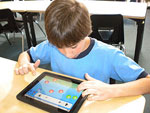BROWSE BY CATEGORY
- Archives and Libraries
- Blogs and Networking
- Bookmark This
- Digital Tools
- Examples of Teaching
- Exhibits
- Film Reviews
- History and Headlines
- Historic Sites and Museums
- Historical Thinking
- Holidays and Heritage
- Issues and Research
- Lesson Plans
- Material and Visual Culture
- Multimedia
- Organizations and Agencies
- Primary Sources
- Professional Development
- Publications
- Student Activities
- Teaching Materials
- Websites
Elizabeth Glynn on Personal Tablet Computers

Personal tablet computers are everywhere, but what role do personal tablet computers have in the classroom?
This past spring, I was in a graduate class where we discussed the role of technology in education. We watched a YouTube clip on the iSchool Initiative created by Kearns High School, UT, senior Travis Allen. The iSchool Initiative is a vision by Allen to integrate technology into the classroom through the use of the iPod Touch and the iPad. These two products would assist in instruction of the students in all subjects. We watched Allen introduce the initiative, showing the various ways that these digital devices could aid classroom education. It made me think about the use of personal tablet computers in the classroom—especially, could a personal tablet computer in the classroom help students acquire all the necessary skills and content for a subject?
The personal tablet computer, no matter what model or manufacturer used, has thousands of apps for the classroom. For the history teacher, there are tons of apps that supply primary source documents from the Constitution to telegrams that Abraham Lincoln wrote in the Civil War. If your students need to develop their literacy skills, you can buy hundreds of apps for students that aid in reading comprehension. Whatever the subject, there are apps available. But is offering content enough? What else could tablets do for teachers and students?
One English teacher that I have worked with in the past uses her tablet computer to create a learning station for the activity part of a lesson. Students work on different activities throughout the room, and each group takes a turn with the tablet. One example of an activity within a learning station she’s used is having students read a paragraph on a topic and then answer questions on the reading on the tablet. When she reviews the activity, this teacher uploads all the answers onto the smartboard in the classroom for the entire class to see.
Students can also write on tablet computers. There are many apps that allow students to use either their finger or a stylus pen. Students can change ink colors and even erase what they create. These features let teachers use a tablet as a shout-out board or a way for groups to answer with more than typed text in activities. They can create math problems, answer math problems, or draw pictures.
The zoom features on tablet computers lend themselves well to analyzing primary sources. In this day and age of “going green,” teachers could avoid printing out copies of a primary source document for all students but instead upload them to a site and allow the students to analyze the documents using the zoom features. This would work especially well with artwork. It is difficult to print perfect, true-to-life copies of artwork from the computer, but with the tablet computer, no printer is needed—just access to the site where the artwork is found. This also can work well with maps. There are numerous apps that specialize in world maps, state maps, country maps, and ancient civilization maps. If the teacher loads these apps on the tablet, students can work with the map and zoom in on many different features.
The use of this type of technology in the classroom has many advantages, but what stops many educators from even thinking about using tablets in the classroom is that a full class set is out of reach. But you don’t need to have one for each student to use tablets in the classroom; just having classroom access to one is effective. Supplementing classroom activities by using one tablet could make a major impact on students, as it has for the students of the English teacher I mentioned earlier. Setting up a classroom station that utilizes an app or two on a tablet would engage students in turn. Students could sign out the tablet computer for classroom use and work in groups using it for that activity or assignment. Teachers can also walk around with the tablet computer and stop and allow students to complete a multiple-choice question or math problem or draw a piece of art on the tablet for on-the-spot assessment.
I know that my students like technology and, seeing tablets as the "next big thing," would love working with one. Keeping students engaged in learning a given subject while exposing them to state-of-the-art technology is a great win-win for schools and students.
For more information
Want to learn more about tablets? Social studies consultant Glenn Wiebe gives you the basics in Tech for Teachers.
